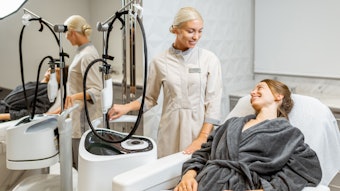
Medical practices place significant emphasis on patient safety and outcomes. But without equal attention to employee safety, patient care can suffer. Low morale, staffing shortages due to injury and the potential for costly fines are just some of the ways a lack of attention to workplace safety can undermine your aesthetic business. Following is an overview of the workplace safety regulatory requirements for medical practices as well as steps you can take to create a culture of safety in your facility.
The Letter of the Law
When people think of workplace safety, OSHA often comes to mind. The Occupational Safety and Health Act of 1970 (OSHA) established standards for all U.S. businesses—including unique regulations for healthcare providers.
OSHA standards dictate that all general industry businesses (which includes healthcare) must follow the “General Duty Clause” that states that each employer will furnish each of his employees a place of employment free from recognized hazards that could cause physical harm or death. Some of the key risks that must be mitigated include non-ergonomic equipment or practices, workplace violence and communicable disease.
OSHA requires employers to provide an OSHA compliance manual to all employees as well as ongoing staff training, notes Christopher E. Poole, MBA, an associate of Medical Management Associates. For healthcare facilities, the manual must include an Exposure Control Plan (ECP), including Blood Borne Pathogens (BBP); Hazard Communication (HAZCOM) on hazardous chemicals used or stored in the facility; as well as a Tuberculosis (TB) policy that sets forth guidelines to prevent unreasonable exposure. In addition, employers must keep records of workplace injuries and illnesses.
“Failure to maintain OSHA compliance, either willingly or unwillingly, can result in violations, fines, and even jail time depending on the breach,” says Poole. “The manual covers examples of safety and health compliance and regulatory requirements that should be reviewed and implemented. New employees must undergo OSHA compliance training within 10 days of hire and annually after that. Businesses need to document the training sessions and retain those records for five years.”
Healthcare facilities also have a personal protective equipment (PPE) requirement. “The employer is required to evaluate the workplace and its processes to determine what type of personal protective equipment is needed to protect employees,” says Keith Brown, safety and health consultant at the University of South Florida, SafetyFlorida Consultation Program. These may include eye protection for laser treatments and face masks to prevent exposure to bloodborne pathogens.
BBP regulations also require establishing and maintaining a needle-stick (or sharps) log, in addition to Illness and Injury reporting logs. “If anyone is stuck with a contaminated needle, that incident would need to be tracked through the sharps log,” says Brown.
Medical practices must also adhere to physical facility standards. These cover safety concerns such as egress (proper number of exits), fire suppression equipment and carbon monoxide detectors.
What if you lease the facility? Still, the practice owner “is responsible for the safety of personnel under the General Duty Clause,” says Marc A. Bianco, COO/EVP of technical services at United Alliance Services, a company that provides OSHA and workplace safety consulting and training. “So whether or not you own the building, if you are aware of a hazard in the building and don’t take action, you could be cited by OSHA.”
In the event that OSHA does make a call on your practice, be prepared and be informed. “Other than in cases of imminent danger and fatal accidents, inspections are most commonly triggered by employee complaints,” says Poole. If your practice is inspected, he encourages owners to be cooperative and friendly, but do not hesitate to ask questions.
“If the inspection is due to a complaint, the OSHA officer must read the complaint before a walk-through of the facility,” says Poole. “Although the officers can go anywhere they like in the practice and can interview employees, the practice should only show them the area(s) that relate to the complaint. Do not volunteer any information. A closing conference will be conducted to discuss findings and propose steps to remedy the situation.”
Businesses typically have the opportunity—particularly on the first offense—to take corrective action if a violation is found. If corrective action is not taken, penalties can increase significantly.
Intersection of Patient and Worker Safety
OSHA requirements are often viewed as pertaining primarily to manufacturing facilities and construction sites, because these jobs are perceived as high risk. This changed for many in the healthcare field when 2007-2009 statistics from OSHA, the Centers for Disease Control and Prevention, and the Institutes of Medicine revealed that healthcare workers experience some of the highest rates of nonfatal occupational illness and injury—exceeding those in the construction and manufacturing industries.
Image copyright Getty Images
[pagebreak]
So what can private practices and medspas learn from the larger healthcare facilities that are making workplace safety a priority? One, staff and patient safety cannot be separated. A 2012 monograph on “Improving Patient and Worker Safety” issued by the Joint Commission in conjunction with the National Institute for Occupational Safety and Health (NIOSH), National Occupational Research Agenda (NORA) Healthcare and Social Alliance Sector Council, identified key areas where worker and patient safety intertwine. They include: lifting and transport of patients; poor lighting; slips and falls due to unsafe flooring surfaces; understaffing of facilities that leads to fatigue and poor practices; infection control; and workplace violence.
In addition to training employees in correct lifting techniques and the use of technologies to help transport patients, the Joint Commission monograph offers protocols to address concerns such as:
Slips and Falls. Use non-slip flooring, and keep all flooring surfaces dry and free of clutter.
Needle pricks. Use sharps with engineered sharps injury protection; use blunt cannulas and suture needles to prevent needle sticks; and minimize hand transfers of surgical instruments.
Infection prevention. Comply with CDC hand hygiene guidelines and CDC recommendations for influenza vaccinations. Use correct personal protective equipment.
Workplace Violence. Track patients with a history of disruptive behavior and train staff on how to respond. This may include:
-Watching for warning signs and trusting one’s gut feelings.
-Using simple, direct commands to gain patient cooperation.
-Staying at least two arm lengths away from an agitated patient.
-Being aware of where the exit is located and not allowing the patient to get between you and the door.
-Asking bystanders to move away from the area.
-Avoiding arguments or inflammatory language.
-Giving the patient a sense of control by offering choices (when appropriate).
Creating a Culture of Safety
Protecting the well-being of your employees and patients, and ensuring that your business is in compliance with OSHA standards requires a top-down as well as a bottom-up approach. “Owners and management should be visible supporters and promoters of safety,” says Bianco.
He recommends appointing an internal safety officer to ensure consistent adherence to safety requirements. Some of the duties of the safety officer, as outlined in the Joint Commission monograph include:
- Conducting periodic hazard analyses
- Examining data from OSHA Illness and Injury logs (Forms 300, 300A and 301), patient incident reporting systems, and human resources (such as job satisfaction surveys, turnover and absenteeism) to identify patterns and trends.
- Developing and improving non-punitive incident reporting systems and encouraging reporting for safety incidents, hazards, errors and near misses.
- Investigating worker and patient safety events, errors and near misses to understand and identify contributing factors.
“The best way to create a culture of safety is through training, review, retraining and open communication,” says Poole. He recommends ongoing safety training and discussion that starts with escorting new employees throughout the practice to show them the location and proper use of spill kits, first aid kits, hand and eye wash stations, fire extinguishers and personal protective equipment. “Providing an extensive onboarding process sets a precedent for the importance of workplace safety,” says Poole.
But to truly create a culture of safety, employees must also be involved in shaping protocols and identifying risks. Poole and Brown encourage practice owners to carve out a few minutes during routine staff meetings to discuss safety concerns and areas for improvement. In addition, implement daily huddles to review any safety-related issues that have occurred in the practice during the previous 24 hours. “Through these efforts, employees will recognize that they have helped define and create the company’s safety culture, which in turn allows them to become vested in it,” says Brown.
Creating Accountability
There are several ways to track adherence to safety pro–tocols including no-blame reporting on potential risks, daily huddles, inspections by the internal safety officer and staff surveys.
“If there are complaints or injuries, make sure that owners, managers and, most importantly, employees are involved in the corrective actions,” says Bianco. “Reiterate to employees that they are responsible for their own safety in addition to that of their coworkers.”
Poole recommends including adherence to safety standards as part of performance reviews, and rewarding employees who follow protocols and raise risk concerns.
“Additionally, inspecting work areas and providing feedback holds employees accountable and provides context for what is expected and acceptable within the practice’s standards,” he says. “Owners and managers need to support employees who increase their safety performance and counsel employees who are not meeting standards.”
As an employer, you are responsible for the well-being of your employees—as well as your patients’—while they are on your property. In addition to causing harm to the individual, workplace injuries can wreak havoc on your staffing, derail morale and undermine patient confidence. The threat of fines and penalties is just one of many reasons why it is in your best interest to develop and reinforce an environment of safety in your workplace.
Image copyright Getty Image
[pagebreak]
ASLMS Laser and Energy Device Plume Safety Guidelines
In addition to eye protection, practices that perform laser and energy-based device treatments should also be protecting employees and patients against potential pathogens released by vaporized tissue during treatment. In April 2017, the American Society for Laser and Medicine Surgery’s Laser Plume Committee released the following safety guidelines.
1. All medical personnel should consider vaporized and ejected tissue plume to be potentially hazardous both in terms of the particulate matter and infectivity.
2. Evacuator suction systems should always be used to collect the plume.
3. The suction should have a high-flow volume with filter changes being made per manufacturer’s recommendations to optimize suction and filter capabilities.
4. Filters should be chosen which allow for maximum filtering efficiency.
5. The suction tip must be placed as close to laser impact as possible.
6. For nanosecond and shorter pulsed lasers, physical barriers that capture the ejected debris or smoke evacuators should be used.
7. Evacuator suction tips and physical barriers should be handled per manufacturer recommendations after each procedure to eliminate the risk of cross-contamination.
8. Eye protection, masks, gloves, and appropriate clothing should be worn during laser use by all laser personnel when vaporized or ejected tissue plume is generated. Eye protection should be of a nature that would protect from splatter (as well as wavelength-specific if a laser is used).
9. Masks should fit well and have highly effective filtration down to the smallest particle size available.
10. Non-sterile gloves should be worn.
Shelley Moench-Kelly, MBA, is a Vermont-based freelance writer and editor.
Image copyright Getty Images











